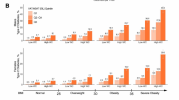Eddy Edson
Well-Known Member
- Relationship to Diabetes
- Type 2
Pretty cool ....
Simple 2D silhouette images + some AI smarts perform well in assesing body fat distribution, almost as well as expensive/time consuming MRI-based etc methods. This can be used for quick screening for CV, T2D etc risks much more accurately & at a deeper level of granularity than eg waist circumference or BMI-based methods.
The metric they use is the visceral fat : abdominal subcutaneous fat ratio (VAT / ASAT). The silhouette method does a good job of estimating this and it can add a lot of grnular information about risk.

As BMI increases, so does T2D prevalence on average. But within each BMI band, waist circumference adds more granular precision: having a high BMI but low WC means that risk may be no more than for a "normal" BMI, on average. Etc etc etc. That is all standard.
But the WC metric can't distinguish between those who have lots of unhealthy visceral fat vs those with lots of OK subcutaneous fat. The VAT / ASAT metric which these guys estimate takes this into account, adding a further layer of granularity.
So if you have a high VAT / ASAT, a low WC and a "normal" BMI, you might have a higher T2D risk than some obese people, but normal BMI / WC type screening would not pick you out as at risk.
ABSTRACT
Background: Inter-individual variation in fat distribution is increasingly recognized as clinically important but is not routinely assessed in clinical practice because quantification requires medical imaging.
Objectives: We hypothesized that a deep learning model trained on an individual's body shape outline – or “silhouette” – would enable accurate estimation of specific fat depots, including visceral (VAT), abdominal subcutaneous (ASAT), and gluteofemoral (GFAT) adipose tissue volumes, and VAT/ASAT ratio. We additionally set out to study whether silhouette-estimated VAT/ASAT ratio may stratify risk of cardiometabolic diseases independent of body mass index (BMI) and waist circumference.
Methods: Two-dimensional coronal and sagittal silhouettes were constructed from whole-body magnetic resonance images in 40,032 participants of the UK Biobank and used to train a convolutional neural network to predict VAT, ASAT, and GFAT volumes, and VAT/ASAT ratio. Logistic and Cox regressions were used to determine the independent association of silhouette-predicted VAT/ASAT ratio with type 2 diabetes and coronary artery disease.
Results: Mean age of the study participants was 65 years and 51% were female. A deep learning model trained on silhouettes enabled accurate estimation of VAT, ASAT, and GFAT volumes (R2 : 0.88, 0.93, and 0.93, respectively), outperforming a comparator model combining anthropometric and bioimpedance measures (ΔR2 = 0.05-0.13). Next, we studied VAT/ASAT ratio, a nearly BMI- and waist circumferenceindependent marker of unhealthy fat distribution. While the comparator model poorly predicted VAT/ASAT ratio (R2 : 0.17-0.26), a silhouette-based model enabled significant improvement (R2 : 0.50- 0.55). Silhouette-predicted VAT/ASAT ratio was associated with increased prevalence of type 2 diabetes and coronary artery disease.
Simple 2D silhouette images + some AI smarts perform well in assesing body fat distribution, almost as well as expensive/time consuming MRI-based etc methods. This can be used for quick screening for CV, T2D etc risks much more accurately & at a deeper level of granularity than eg waist circumference or BMI-based methods.
The metric they use is the visceral fat : abdominal subcutaneous fat ratio (VAT / ASAT). The silhouette method does a good job of estimating this and it can add a lot of grnular information about risk.

As BMI increases, so does T2D prevalence on average. But within each BMI band, waist circumference adds more granular precision: having a high BMI but low WC means that risk may be no more than for a "normal" BMI, on average. Etc etc etc. That is all standard.
But the WC metric can't distinguish between those who have lots of unhealthy visceral fat vs those with lots of OK subcutaneous fat. The VAT / ASAT metric which these guys estimate takes this into account, adding a further layer of granularity.
So if you have a high VAT / ASAT, a low WC and a "normal" BMI, you might have a higher T2D risk than some obese people, but normal BMI / WC type screening would not pick you out as at risk.
ABSTRACT
Background: Inter-individual variation in fat distribution is increasingly recognized as clinically important but is not routinely assessed in clinical practice because quantification requires medical imaging.
Objectives: We hypothesized that a deep learning model trained on an individual's body shape outline – or “silhouette” – would enable accurate estimation of specific fat depots, including visceral (VAT), abdominal subcutaneous (ASAT), and gluteofemoral (GFAT) adipose tissue volumes, and VAT/ASAT ratio. We additionally set out to study whether silhouette-estimated VAT/ASAT ratio may stratify risk of cardiometabolic diseases independent of body mass index (BMI) and waist circumference.
Methods: Two-dimensional coronal and sagittal silhouettes were constructed from whole-body magnetic resonance images in 40,032 participants of the UK Biobank and used to train a convolutional neural network to predict VAT, ASAT, and GFAT volumes, and VAT/ASAT ratio. Logistic and Cox regressions were used to determine the independent association of silhouette-predicted VAT/ASAT ratio with type 2 diabetes and coronary artery disease.
Results: Mean age of the study participants was 65 years and 51% were female. A deep learning model trained on silhouettes enabled accurate estimation of VAT, ASAT, and GFAT volumes (R2 : 0.88, 0.93, and 0.93, respectively), outperforming a comparator model combining anthropometric and bioimpedance measures (ΔR2 = 0.05-0.13). Next, we studied VAT/ASAT ratio, a nearly BMI- and waist circumferenceindependent marker of unhealthy fat distribution. While the comparator model poorly predicted VAT/ASAT ratio (R2 : 0.17-0.26), a silhouette-based model enabled significant improvement (R2 : 0.50- 0.55). Silhouette-predicted VAT/ASAT ratio was associated with increased prevalence of type 2 diabetes and coronary artery disease.
